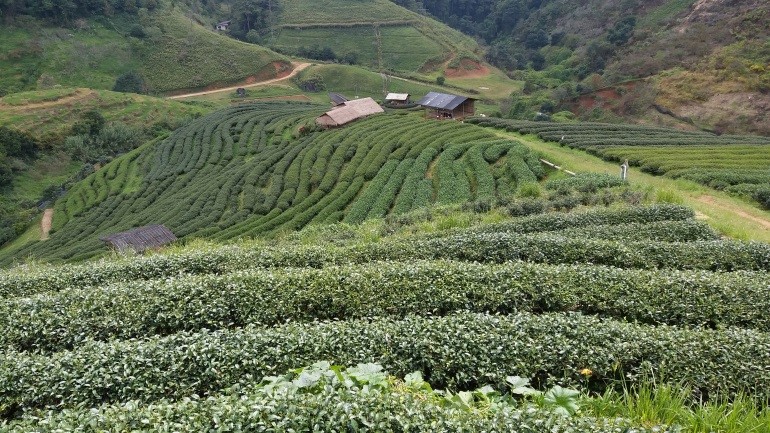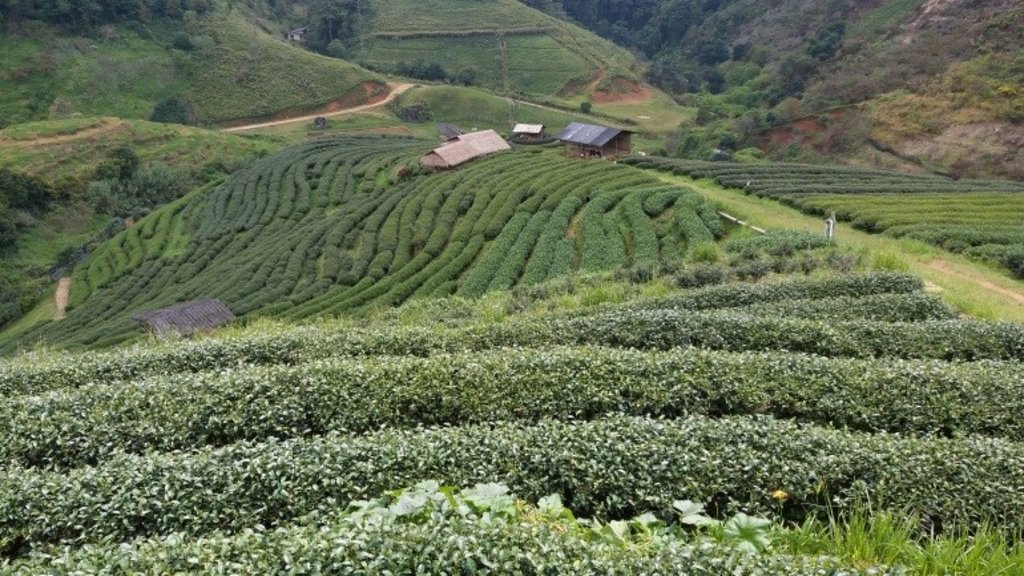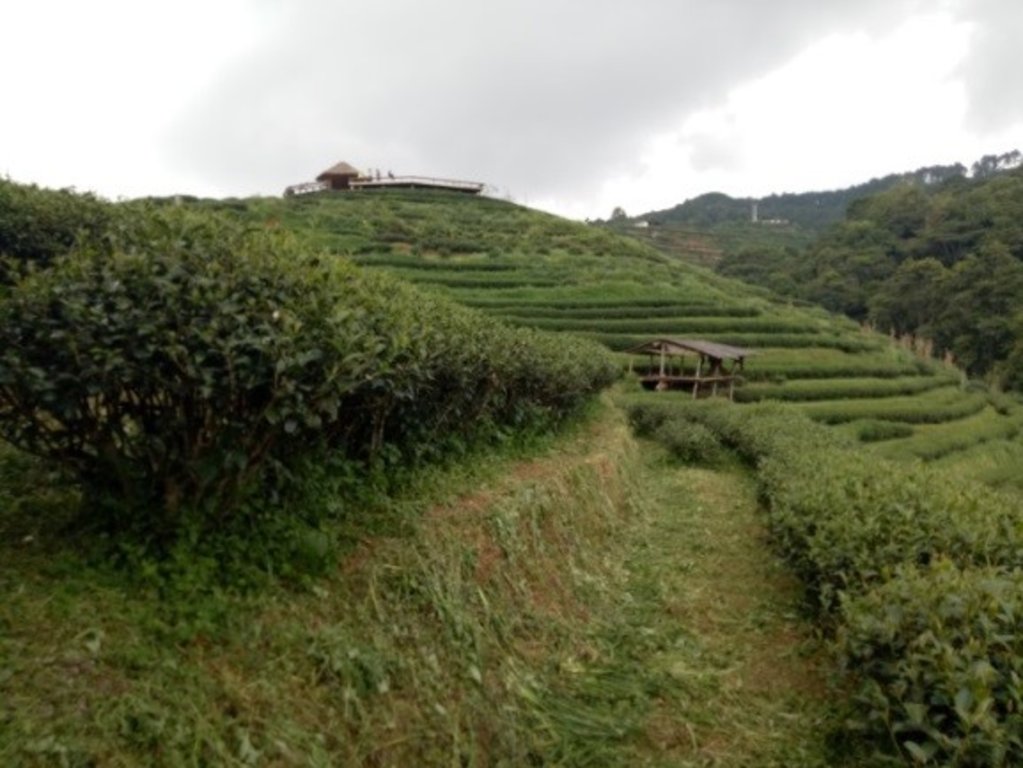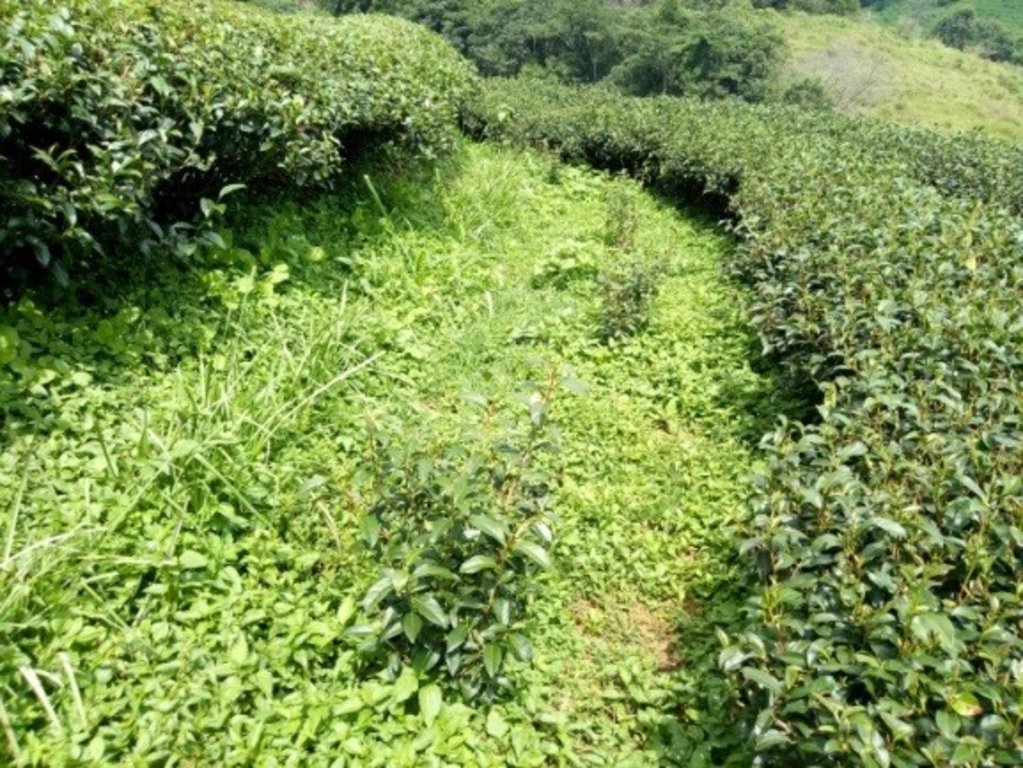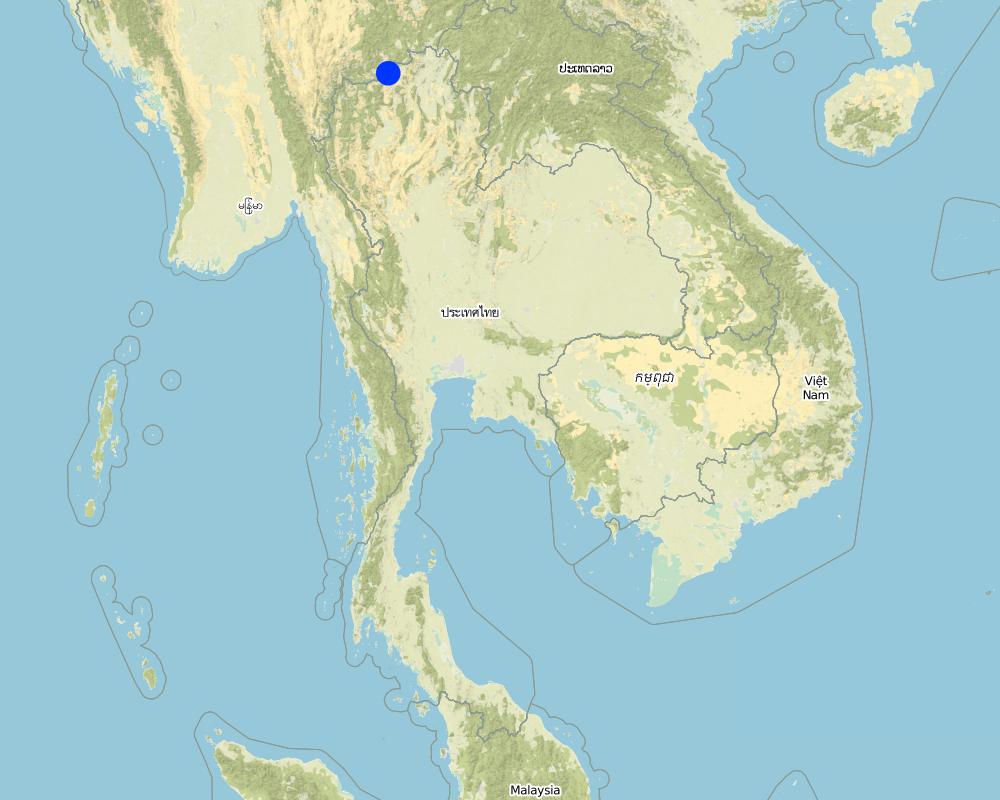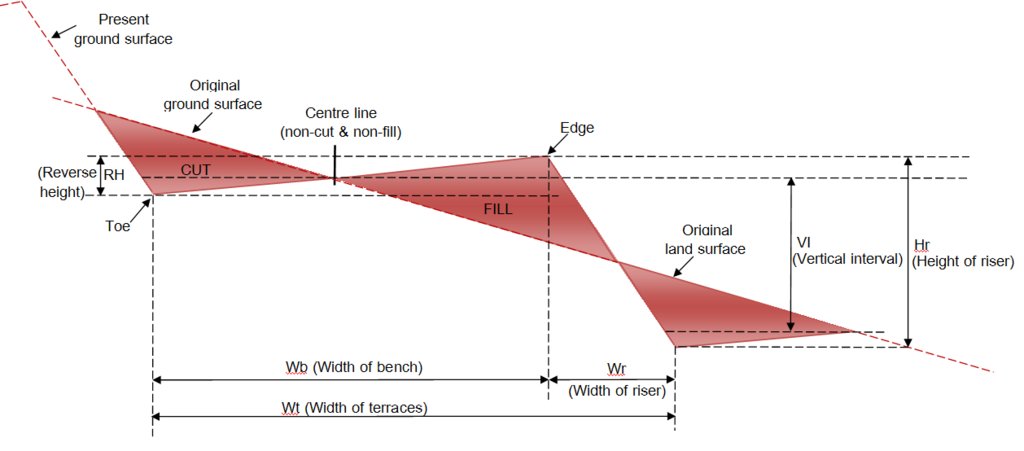Continuous bench terrace in high sloping area for tea plantation [ប្រទេសថៃ]
- ការបង្កើត៖
- បច្ចុប្បន្នភាព
- អ្នកចងក្រង៖ Pitayakon Limtong
- អ្នកកែសម្រួល៖ –
- អ្នកត្រួតពិនិត្យ Rima Mekdaschi Studer
Continuous bench terrace in high sloping area for tea plantation
technologies_4281 - ប្រទេសថៃ
ពិនិត្យមើលគ្រប់ផ្នែក
ពង្រីកមើលទាំងអស់ បង្រួមទាំងអស់1. ព័ត៌មានទូទៅ
1.2 ព័ត៌មានលម្អិតពីបុគ្គលសំខាន់ៗ និងស្ថាប័នដែលចូលរួមក្នុងការវាយតម្លៃ និងចងក្រងឯកសារនៃបច្ចេកទេស
បុគ្គលសំខាន់ម្នាក់ (ច្រើននាក់)
co-compiler:
Tipvong Tanomkwan
Land Development Department
ប្រទេសថៃ
អ្នកប្រើប្រាស់ដី:
Mokngoen Jai
Palaung hill tribe farmer
ប្រទេសថៃ
Local officer of Station:
Tapangtong Werapong
Angkhang Royal Agricultural Station
ប្រទេសថៃ
local officer of LDD:
Boonchoo Sontaya
Royal Project Land Development Center, Land Development Department
ប្រទេសថៃ
ឈ្មោះអង្គភាពមួយ (ច្រើន) ដែលបានចងក្រងឯកសារ/ វាយតម្លៃបច្ចេកទេស (បើទាក់ទង)
Land Development Department (Land Development Department) - ប្រទេសថៃ1.3 លក្ខខណ្ឌទាក់ទងទៅនឹងការប្រើប្រាស់ទិន្នន័យដែលបានចងក្រងតាមរយៈ វ៉ូខេត
អ្នកចងក្រង និង(បុគ្គលសំខាន់ៗ)យល់ព្រមទទួលយកនូវលក្ខខណ្ឌនានាទាក់ទងទៅនឹងការប្រើប្រាស់ទិន្នន័យដែលបានចងក្រងតាមរយៈវ៉ូខេត:
បាទ/ចា៎
1.4 សេចក្តីប្រកាសស្តីពីចីរភាពនៃការពណ៌នាពីបច្ចេកទេស
តើបច្ចេកទេសដែលបានពណ៌នានេះមានបញ្ហាដែលផ្តោតលើការធ្លាក់ចុះគុណភាពដី, បើដូច្នេះវាមិនអាចត្រូវបានប្រកាសថាជាបច្ចេកទេសនៃការគ្រប់គ្រងប្រកបដោយចីរភាពទេ?
ទេ
មតិយោបល់:
This continuous bench terrace with 3 meters base in slopping highland constructed at Plot 2000 for Chinese tea plantation. Such conservation measure can decrease soil erosion and runoff, and this slopping area can use for agriculture and increase land users products and income.
2. ការពណ៌នាពីបច្ចេកទេស SLM
2.1 ការពណ៌នាដោយសង្ខេបពីបច្ចេកទេស
និយមន័យបច្ចេកទេស:
Utilization of continuous bench terrace (3 meters based) as sustainable soil and water conservation measure for tea plantation in slopping area of the northern Thailand
2.2 ការពណ៌នាលម្អិតពីបច្ចេកទេស
ការពណ៌នា:
The continuous bench terrace (forward-sloping terrace) as soil and water conservation measure in the high landscape at Angkhang Royal Agricultural Station, Moo 5, Mae Ngon subdistrict, Fang district, Chiang Mai province was constructed in 1999 in the area of former winter fruit plantation plot of the station. Land Development Department had surveyed, designed and constructed the 3 meters wide of continuous bench terrace, which it is suitable for the tea cultivation and total area is approximately 100 rai. The Angkhang Royal Agricultural Station had selected 50 households of Palaung hill tribe who have more ability and aptitude to grow Chinese tea to participate in the Chinese tea development and promotion project in 2000 and named this area as "Plot 2000". The overview of this area is complex mountainous terrain with slope range 16-30 percent, and average attitude is 1,400 meters above sea level. The soil texture is silty loam and very deep (more tan 1.2 meter), almost well drained soil. The soil organic matter is moderate around 1-3 percent. Moreover, the data of Doi Ang Khang Meteorological Station (Station Code 48302) is located at average attitude 1,529 meters above the sea level, and average temperature throughout the year is 22.9 Celsius with the highest temperature is 32.1 Celsius (during May) and the lowest temperature is 3.9 Celsius (during December), and average annual rainfall is 1,925.3 mm, with rain starting from April to October.
In the past, the watershed areas in northern Thailand have been disturbed by natural disasters, climate change, and human threats. The hill tribe people had invaded the forest to grow opium and shifting cultivation continuously. These condition caused the serious problem in soil erosion, runoff with soil surface, lose of topsoil and plant nutrients, decreasing in soil fertility and productivity with the extremely damage to upstream forest ecosystem. Until in the year 1969, Angkhang Royal Agricultural Station was established from the initiative of His Majesty King Rama 9, which aimed to conduct research on the planting of winter economic crops as an example for hill tribe to plant those crops as their career instead of opium cultivation, and also stop cutting and shifting cultivation. Nowadays there are more than 50 species of economic plants in this project and generating more income for land users, more than that this slopping area is the sustainable in land use and land management under organization of the Royal Project Foundation.
The benefits this technology is important in sustainable utilization of land resources in this area, and all land users around the Angkhang Royal Agricultural Station have stable and more income because they can grow Chinese tea and also other winter economic crops on this highland throughout the year. Moreover, this continuous bench terrace is more convenient for land users in fertilizer application, soil improvement, machines operation, tea harvesting and also yield transportation from cultivated plots to local processing factory.
The impact of implementation continuous bench terrace with 3 meters based:
1. The obvious economic and social impacts of land users are the stability of income from the production of Chinese tea, which are produced throughout the year. This conservation is more convenient for land users to implement in their plot and also transport from cultivated plots to local processing factory. The local officers from Angkhang Royal Agricultural Station and others government agencies closely advised and guided breeding, planting, soil management, harvesting and price guarantee.
2. The environmental and ecological impact is to reduce the amount of runoff and soil sediment, increase soil moisture, preserve soil nutrients and fertility, encourage biodiversity in the area of Plot 2000.
3. The society and culture impact is all ethnic groups are given the opportunity to receive the allocation of arable land according to the group of plants that they are comfortable and want to produce. Thus respecting the use of land in zoning as allocated from the station, including right to use water. These caused the strength of community institutions, where they have various crop production groups, organic fertilizer production Group and others. They are all member of the cooperative of the community.
2.3 រូបភាពនៃបច្ចេកទេស
កំណត់សម្គាល់ទូទៅនៃរូបថត/រូភាព:
Soil and water conservation measure (3-meter base) as continuous bench terrace with Chinese tea cultivation on highland (at Plot 2000). The winter fruit trees in this area of AngKhang Royal Agricultural Station has been changed to the bench terrace for Chinese tea plantation with good agricultural practices (GAP) more than 19 years, which shows the appropriate land use conditions in sustainable soil and water conservation.
2.4 វីដេអូនៃបច្ចេកទេស
កាលបរិច្ឆេទ:
14/10/2018
ទីតាំង:
Ban Thap Sub-District, Mae Chaem District, Chiang Mai Province, 50270
ឈ្មោះអ្នកថតវីឌីអូ:
Ms. Somjit Lertdisayawan / Ms. Tanomkwan Tipvong
2.5 ប្រទេស/តំបន់/ទីតាំងកន្លែង ដែលបច្ចេកទេសត្រូវបានអនុវត្ត និងបានគ្រប់ដណ្តប់ដោយការវាយតម្លៃនេះ
ប្រទេស:
ប្រទេសថៃ
តំបន់/រដ្ឋ/ខេត្ត:
Ban Thap Sub-District, Mae Chaem District, Chiang Mai Province, 50270
បញ្ជាក់បន្ថែមពីលក្ខណៈនៃទីតាំង:
Extension area for Chinese tea plantation (Plot 2000) at Angkhang Royal Agricultural Station, Mae Ngon Subdistrict, Fang District, Chiang Mai ProvincePlot
បញ្ជាក់ពីការសាយភាយនៃបច្ចេកទេស:
- ត្រូវបានផ្សព្វផ្សាយត្រឹមតំបន់មួយ
ប្រសិនបើមិនច្បាស់ពីទំហំផ្ទៃដី សូមធ្វើការប៉ាន់ប្រម៉ាណ:
- 0.1-1 គម2
មតិយោបល់:
Angkhang Royal Agricultural Station is an area for research and development for the winter crops and trees around 1,811 rai, with high from the sea level 1,400 meters. There are hill tribe villages around the station and the total population is about 3,215 people. The weather is cool all year round with the average temperature is 17.7 degrees, the maximum temperature is 32 degrees in April. And the minimum temperature of -3 degrees in January. The average rainfall is 2,075 mm per year and slope area 20-35%.
Map
×2.6 កាលបរិច្ឆេទនៃការអនុវត្ត
បង្ហាញឆ្នាំនៃការចុះអនុវត្ត:
1999
ប្រសិនបើមិនច្បាស់ឆ្នាំ សូមបញ្ជាក់កាលបរិច្ឆេទដែលប្រហាក់ប្រហែល:
- 10-50 ឆ្នាំ
2.7 ការណែនាំពីបច្ចេកទេស
សូមបញ្ជាក់តើបច្ចេកទេសត្រូវបានណែនាំឱ្យអនុវត្តដោយរបៀបណា:
- តាមរយៈគម្រោង / អន្តរាគមន៍ពីខាងក្រៅ
មតិយោបល់ (ប្រភេទនៃគម្រោង ។ល។):
The Royal Project implement in the upstream forest area and emphasize to promote and encourage career of hilltribe land users around AngKhang Agricultural Station. Moreover, the continuous bench terrace is introduced in this high slope area to prevent and conserve soil and water resources, reduce soil erosion and runoff.
3. ចំណាត់ថ្នាក់នៃបច្ចេកទេស SLM
3.1 គោលបំណងចម្បង (១ ឬច្រើន) នៃបច្ចេកទេសនេះ
- ធ្វើឱ្យប្រសើរឡើងនូវផលិតកម្ម
- កាត់បន្ថយ, បង្ការ, ស្តារឡើងវិញនូវការធ្លាក់ចុះគុណភាពដី
- អភិរក្សប្រព័ន្ធអេកូឡូស៊ី
- អភិរក្ស/ធ្វើឱ្យប្រសើរឡើងជីវចម្រុះ
- បង្កើតផលប្រយោជន៍សេដ្ឋកិច្ច
3.2 ប្រភេទដីប្រើប្រាស់មួយប្រភេទ (ច្រើនប្រភេទ) ដែលបានអនុវត្តបច្ចេកទេស

ដីដាំដំណាំ
- ដំណាំរយៈពេលវែង (មិនមែនឈើ)
- Tea
ចំនួនសារដែលដាំដំណាំក្នុងមួយឆ្នាំ:
- 1
សូមបញ្ជាក់:
Chinese tea, Camellia sinensis var. sinensis in 15.43 sq.km. or 96.4375 Rai.
មតិយោបល់:
Palaung hill tribe will plant Chinese tea on this area in late rainy season, about August to October because after planting root of tea would grow well in the cool condition and do not face problems like during the rainy season. The trimming will be about 10-12 months before planting. spacing between row is 1.2 meter and between tree is 60 centimeters. There are about 2,200 trees per Rai.
3.3 បន្ទាប់ពីអនុវត្តបច្ចេកទេស តើដីប្រើប្រាស់មានការប្រែប្រួលដែររឺទេ?
មតិយោបល់:
-
3.4 ការផ្គត់ផ្គង់ទឹក
ការផ្គត់ផ្គង់ទឹកនៅកន្លែងអនុវត្តបច្ចេកទេស:
- ទឹកភ្លៀង និងប្រព័ន្ធស្រោចស្រព
មតិយោបល់:
The land use in this area is Chinese tea in Plot 2000, with 2 species, namely soft stalks and variety no.12, This area is mainly rain fed together with spraying system. And water supply system is in the upper part of the area and distribute to tea plot by PVC pipe and set springier cover over this plot. however, this water system is high cost but it is worthwhile.
3.5 ក្រុម SLM ដែលបច្ចេកទេសស្ថិតនៅក្នុង
- វិធានការអនុវត្តកាត់ទទឹងទីជម្រាល
- កាត់បន្ថយហានិភ័យនៃបញ្ហាលើប្រព័ន្ធអេកូឡូស៊ី
3.6 វិធានការ SLM ដែលបញ្ចូលនូវបច្ចេកទេស

វិធានការរុក្ខជាតិ
- V2: ស្មៅនិងរុក្ខជាតិៗដែលដុះមានអាយុមិនលើសពី 2ឆ្នាំ

វិធានការរចនាស័ម្ពន្ធ
- S1: ការធ្វើដីថ្នាក់ៗតាមជម្រាលភ្នំ
មតិយោបល់:
The continuous bench terrace technology is suitable soil and water conservation in slopping area,where is the upper part of watershed in the National Reserved Forest area. This technology need knowledge and expertise in construction of conservation measure with high investment and more maintenance. That means government and private sector should support in construction and land users should maintain of bench terrace and take care in soil fertility.
3.7 កំណត់ប្រភេទនៃការធ្លាក់ចុះគុណភាពដីសំខាន់ៗដែលបច្ចេកទេសនេះបានដោះស្រាយ

ការហូរច្រោះដីដោយសារទឹក
- Wt: ការបាត់ដីស្រទាប់លើដោយការហូរច្រោះ
មតិយោបល់:
Soil resources in this area is degraded by deforestation and climate changes, where it is risk in runoff and soil erosion. In this case plant nutrients in soil surface and sediment is removed to the low part, soil fertility is decreased, and ecosystem in upstream forest is degraded.
3.8 ការពារ កាត់បន្ថយ ឬស្តារឡើងវិញនៃការធ្លាក់ចុះគុណភាពដី
បញ្ជាក់ពីគោលដៅរបស់បច្ចេកទេស ដែលផ្តោតទៅការធ្លាក់ចុះគុណភាពដី:
- ការការពារការធ្លាក់ចុះគុណភាពដី
- ការកាត់បន្ថយការធ្លាក់ចុះគុណភាពដី
មតិយោបល់:
In 1999, the Angkhang Royal Agricultural Station cooperated with Land Development Department construct the continuous bench terrace and soil improvement in this steep slope area to prevent soil erosion and runoff. Moreover, the Royal Irrigation Department support water supply system and the Provincial Electricity Authority support electricity services.
4. បច្ចេកទេសជាក់លាក់ សកម្មភាពអនុវត្ត ធាតុចូល និងថ្លៃដើម
4.1 គំនូសបច្ចេកទេសនៃបច្ចេកទេសនេះ
លក្ខណៈពិសេសនៃបច្ចេកទេស (ទាក់ទងនឺងគំនូរបច្ចេកទេស):
Operation in tea plantation in Plot 2000:
1. During 1999-2000, Angkhang Royal Agricultural Station, in collaboration with Land Development Department, conducted a survey to select the highland mountainous area with slope 20-35 percent, where land is deteriorated conditions, risk of erosion and landslides, low fertility. In order to design and construct soil and water conservation measure as continuous bench terrace with 3 meters based for Chinese tea plantations as a plot to demonstrate and promote the conservation measure on such area for Palaung hill tribe. Soil in this area is Mae Taeng soil series where it is very deep soil, with texture is sandy loam to sandy loamy, dark brown in color and soil reaction is slightly acidic (pH 5.5-6.5). In lower layer of soil profile is clay, dark red to red and soil reaction is very acidic to acidic (pH 4.5-5.5)
2. Set up the digging contour line by using wood pole from the highest point of the area to the lowest point and used the upper line is the first line of the terrace. Then dig the next contour line down along the slope and distance between the contour line is equal to distance of each terrace that is 3 meters. After that dig the terrace as 3 meters based on the contour line and set the level of terrace inclined around 1-2 degrees to drain water from this area.
3. The operation of cut and fill of soil along the contour line and move the surface soil and reshape the surface soil in this area. And dig the soil by using manpower or machine from the lower edge of the plot to make the terrace in the upper part. Therefore move, adjust and compact the soil in this area and reshape surface of soil and make terrace with 3.0 meters width and incline about 1-2 degrees, and make additional 10 percent of soil thickness to prevent the collapse, and keep the soil organic matter on the upper part of the floor and height of each terrace should not more than 1.8 meters, therefore cutting the soil down to 0.9 meters and filling the soil 0.9 meters.
4. Vetiver grass plantation conserved 2 rows of terrace by planting over the top of the terrace and planting another 1 row over the filled soil and planting spacing is 10 centimeters.
5.1 After bench terrace construction is completed in 2000, where Angkhang Royal Agricultural Station selected land users and allocated land for tea plantation for 50 households of Palaung hill tribe to set experiment of 2 varieties of Chinese tea as soft stem and breed number 12 varieties.
5.2 Land users usually planted Chinese tea at late of rainy season, which is about August to October as suitable planting season. Because after planting in this period, the root of the tea will affect the cold condition that make they grow well and do not face problems like during the rainy season
5.3 The planting period of the cutting stalk will be about 10-12 months before planting. The planting spacing is 1.2 meters in length. The spacing between stalk is 60 centimeters, and spaced about 40-45 centimeters in a row. There are approximately 2,200 trees per rai.
6. Maintenance of Plot 2000
6.1 Fertilizer application focuses on using compost from animal manure produced by this group. By digging a long groove at the end of the canopy of tea about 15 cm deep on both sides. Compost is applied 2 kilograms per tree a year, and apply 3 times during February, June, October and also use bio-extracted solution spray to tea tree for stretching the shoot with dark green leaf, plump, good weight.
6.2 Irrigation in this area use both from rain and water storage tank in the upper area and distribute directly to the plot by PVC pipe.
6.3 Almost land users in this area harvested their organic tea from April to December and will donant during January-March. At present, the no.12 variety has average yield 800 kilograms per rai, they can harvest 5-6 times a year, while the soft stem variety has average yield 600 kilograms per rai, and can harvest 4-5 times a year. In this case they would have total annual yield 60,000 kilograms and annual average income is 100,000-300,000 baht per household.
7. Maintenance of bench terrace in case of damage by runoff, all land users will repair their terrace by themselves in the dry season. In the serious case of erosion, Land Development Department will support such maintenance at rate of 500 baht per rai.
ឈ្មោះអ្នកនិពន្ធ:
Ms. Tanomkwan Tipvong
4.2 ព័ត៌មានទូទៅដែលពាក់ព័ន្ធនឹងការគណនាធាតុចូល និងថ្លៃដើម
កំណត់របៀបនៃការគណនាថ្លៃដើម និងធាតុចូល:
- ក្នុងតំបន់អនុវត្តបច្ចេកទេស
កំណត់ទំហំ និងឯកត្តាផ្ទៃដី:
The area of continuous bench terrace 3 meter board
បើសិនប្រើឯកតាតាមតំបន់ សូមបញ្ជាក់តម្លៃបម្លែងវាទៅជាហិកតា (ឧ. 1 ហិកតា = 2.47 អា)៖ 1 ហិកតា =:
15.43
ផ្សេងៗ/ រូបិយប័ណ្ណជាតិ (បញ្ជាក់):
Baht
បើពាក់ព័ន្ធសូមកំណត់អត្រាប្តូរប្រាក់ពីដុល្លាទៅរូបិយប័ណ្ណតំបន់ (ឧ. 1 ដុល្លារ = 79.9 រៀលនៃរូបិយប័ណ្ណប្រេស៊ីល) ៖ 1 ដុល្លារ =:
15448,6
កំណត់ថ្លៃឈ្នួលជាមធ្យមនៃការជួលកម្លាំងពលកម្មក្នុងមួយថ្ងៃ:
175.82
4.3 សកម្មភាពបង្កើត
| សកម្មភាព | រយៈពេល (រដូវកាល) | |
|---|---|---|
| 1. | Survey, select the area and design conservation measure | the first year (1998) |
| 2. | set up contour line for terrace | the first year (1998) |
| 3. | construct bench terrace | before of rainy season 1999 |
| 4. | Vetiver grass plantation on the terrace | early of rainy season 1999 |
| 5. | Chinese tea plantation | in rainy season, Aug-Oct 2000 |
| 6. | Fertilizer application 3 times | Feb, Jun and Oct |
| 7. | Water application | throughout the planting period |
| 8. | Fertilizer application | throughout the planting period |
| 9. | Harvest | harvesting period |
| 10. | Maintenance bench terrace | in dry season, April |
មតិយោបល់:
-
4.4 ថ្លៃដើម និងធាតុចូលដែលត្រូវការសម្រាប់ការបង្កើតបច្ចេកទេស
| បញ្ជាក់ពីធាតុចូល | ឯកតា | បរិមាណ | ថ្លៃដើមក្នុងមួយឯកតា | ថ្លៃធាតុចូលសរុប | % នៃថ្លៃដើមដែលចំណាយដោយអ្នកប្រើប្រាស់ដី | |
|---|---|---|---|---|---|---|
| កម្លាំងពលកម្ម | site survey 1 day | man | 0,5 | 175,82 | 87,91 | |
| កម្លាំងពលកម្ម | set up contour line 1 day | man | 4,0 | 175,82 | 703,28 | |
| កម្លាំងពលកម្ម | vetiver planting (400 slips x 8 rows) | slip | 3200,0 | 1,65 | 5280,0 | |
| កម្លាំងពលកម្ម | man power (2.4 cu.m./m.) | cu.m. | 88,0 | 100,88 | 8877,44 | |
| សម្ភារៈ | machine power (2.4 cu.m./m.) | cu.m. | ||||
| សម្ភារៈ | pin wood | unit | 100,0 | 5,0 | 500,0 | |
| សម្ភារៈដាំដុះ | vetiver slip (LDD supported) | None | 3200,0 | |||
| ថ្លៃដើមសរុបក្នុងការបង្កើតបច្ចេកទេស | 15448,63 | |||||
| ថ្លៃដើមសរុបក្នុងការបង្កើតបច្ចេកទេសគិតជាដុល្លារ | 1,0 | |||||
ប្រសិនបើអ្នកប្រើប្រាស់ដីមិនមានថ្លៃដើម 100% សូមបញ្ជាក់ថានរណាដែលចំណាយថ្លៃដើមដែលនៅសល់:
Land Development Department by Center of land development for Royal Project supported the budget by conduct the bench terrace in this area.
មតិយោបល់:
-
4.5 សកម្មភាពថែទាំ
| សកម្មភាព | ពេលវេលា/ ភាពញឹកញាប់ | |
|---|---|---|
| 1. | maintain and repair bench terrace | in dry season 3-5 years/time |
មតិយោបល់:
In the case of bench terrace are not so much damaged, and size of rill is around 5-20 cm. wide and not very deep. Most of the land users usually repair that terrace by themselves during the dry season.
4.6 កំណត់ថ្លៃដើមសម្រាប់ការថែទាំ/ សកម្មភាពរបស់បច្ចេកទេស (ក្នុងរយៈពេលមួយឆ្នាំ)
| បញ្ជាក់ពីធាតុចូល | ឯកតា | បរិមាណ | ថ្លៃដើមក្នុងមួយឯកតា | ថ្លៃធាតុចូលសរុប | % នៃថ្លៃដើមដែលចំណាយដោយអ្នកប្រើប្រាស់ដី | |
|---|---|---|---|---|---|---|
| កម្លាំងពលកម្ម | man power to repair the terrace | man | 1,0 | 500,0 | 500,0 | 100,0 |
| ថ្លៃដើមសរុបសម្រាប់ការថែទាំដំណាំតាមបច្ចេកទេស | 500,0 | |||||
| ថ្លៃដើមសរុបសម្រាប់ការថែទាំដំណាំតាមបច្ចេកទេសគិតជាដុល្លារ | 0,03 | |||||
ប្រសិនបើអ្នកប្រើប្រាស់ដីមិនមានថ្លៃដើម 100% សូមបញ្ជាក់ថានរណាដែលចំណាយថ្លៃដើមដែលនៅសល់:
All maintenance cost of bench terrace are supported by Center of Land Development for Royal Project, Land Development Department.
មតិយោបល់:
Center of Land Development for Royal Project, Land Development Department directly cooperated with the Royal Project.
4.7 កត្តាសំខាន់បំផុតដែលមានឥទ្ធិពលដល់ការចំណាយ
ពណ៌នាពីកត្តាប៉ះពាល់ចម្បងៗទៅលើថ្លៃដើម:
construction of continuous bench terrace and maintenance cost, which it is all invested by government sector, Land Development Department.
5. លក្ខណៈបរិស្ថានធម្មជាតិ និងមនុស្ស
5.1 អាកាសធាតុ
បរិមាណទឹកភ្លៀងប្រចាំឆ្នាំ
- < 250 មម
- 251-500 មម
- 501-750 មម
- 751-1,000 មម
- 1,001-1,500 មម
- 1,501-2,000 មម
- 2,001-3,000 មម
- 3,001-4,000 មម
- > 4,000 មម
កំណត់បរិមាណទឹកភ្លៀង (បើដឹង) ជា មីលីម៉ែត្រ:
1925,30
លក្ខណៈពិសេស/ មតិយោបល់លើរដូវភ្លៀង:
The number of rainy day is 160.9 days per year. The day with the highest daily rain (daily max.) average 149.4 mm/day in October. The number of day has storm average of 57.5 days and highest per year in May is 10.5 days
បញ្ជាក់ឈ្មោះឯកសារយោងនៃស្ថានីយឧតុនិយម:
Doi Angkang (Index station 48302), 19° 55' 53.0" N and 99° 2' 54.0" E, at attitude MSL 1529 m. (2006-2015)
តំបន់កសិអាកាសធាតុ
- មានភ្លៀងមធ្យម
According to data from climatic station 48302 , it is found that the duration of the precipitation period is more than half of the evaporation potential (PET) between May-October or about 6 months (180 days).
5.2 សណ្ឋានដី
ជម្រាលជាមធ្យម:
- រាបស្មើ (0-2%)
- ជម្រាលតិចតួច (3-5%)
- មធ្យម (6-10%)
- ជម្រាលខ្ពស់បន្តិច (11-15%)
- ទីទួល (16-30%)
- ទីទួលចោត (31-60%)
- ទីទួលចោតខ្លាំង (>60%)
ទម្រង់ដី:
- ខ្ពង់រាប
- កំពូលភ្នំ
- ជម្រាលភ្នំ
- ជម្រាលទួល
- ជម្រាលជើងភ្នំ
- បាតជ្រលងភ្នំ
តំបន់តាមរយៈកម្ពស់ :
- 0-100 ម
- 101-500 ម
- 501-1,000 ម
- 1,001-1,500 ម
- 1,501-2,000 ម
- 2,001-2,500 ម
- 2,501-3,000 ម
- 3,001-4,000 ម
- > 4,000 ម
បញ្ជាក់ថាតើបច្ចេកទេសនេះត្រូវបានអនុវត្តន៍នៅក្នុង:
- មិនពាក់ព័ន្ធទាំងអស់
មតិយោបល់ និងបញ្ចាក់បន្ថែមអំពីសណ្ឋានដី :
This technology is used in slope 20-35% , slope complex and slope more than 35%.
5.3 ដី
ជម្រៅដីជាមធ្យម:
- រាក់ខ្លាំង (0-20 សម)
- រាក់ (21-50 សម)
- មធ្យម (51-80 សម)
- ជ្រៅ (81-120 សម)
- ជ្រៅខ្លាំង (> 120 សម)
វាយនភាពដី (ស្រទាប់លើ):
- មធ្យម (ល្បាយ, ល្បាប់)
វាយនភាពដី (> 20 សម ស្រទាប់ក្នុង):
- ម៉ត់/ ធ្ងន់ (ឥដ្ឋ)
សារធាតុសរីរាង្គនៅស្រទាប់ដីខាងលើ:
- មធ្យម (1-3%)
បើអាចសូមភ្ជាប់ការពណ៌នាពីដីឱ្យបានច្បាស់ ឬព័ត៌មានដែលអាចទទួលបាន ឧ. ប្រភេទដី, pH ដី/ ជាតិអាស៊ីត, សមត្ថភាពផ្លាស់ប្តូរកាចុង, វត្តមាននីត្រូសែន, ភាពប្រៃ ។ល។:
Angkhang Royal Agricultural Station is directly respond covered 16,577 rai, with 5 main villages, namely Ban Nala, Ban Rim, Ban Pang Ma, Ban Khum, and Ban Luang. Total population is 3,929 people. The overall landscape is slope complex in mountain range surrounded by a pan-shaped basin. This agricultural area is promoted the hill tribe community to grow winter crops. The general condition of this area is pine forest and evergreen forest. The attitude is 1,400 meters above the sea level. Most of soil series are Ban Luang Series. Soil loamy soil. Angkhang Series is a soil formed by limestone, rock, shell, shale. The overall soil condition is good structure, but almost highland with high slope and acidic condition (pH 4.5-6.0).
5.4 ទឹកដែលអាចទាញមកប្រើប្រាស់បាន និងគុណភាពទឹក
នីវ៉ូទឹកក្រោមដី:
> 50 ម
ទឹកលើដីដែលអាចទាញយកប្រើប្រាស់បាន:
ល្អ
គុណភាពទឹក (មិនបានធ្វើប្រត្តិកម្ម):
ទឹកសម្រាប់តែការធ្វើកសិកម្ម (ស្រោចស្រព)
តើមានបញ្ហាភាពទឹកប្រៃហូរចូលមកដែរឬទេ?
ទេ
តើទឹកជំនន់កំពុងកើតមាននៅតំបន់នេះដែររឺទេ?
ទេ
មតិយោបល់ និងលក្ខណៈពិសេសផ្សេងៗទៀតលើគុណភាព និងបរិមាណទឹក :
In the past, there was no soil and water conservation measure, where soil erosion and severe runoff is occurred when it has heavy rain, especially during the rainy season. Soil surface was transported to the lower part, where organic matter and plant nutrients lost from this area and small rill and deep groove is formed in the upper part. Moreover such soil sediment in runoff accumulated in the channel and natural reservoir.
5.5 ជីវៈចម្រុះ
ភាពសម្បូរបែបនៃប្រភេទ:
- ខ្ពស់
ភាពសម្បូរបែបនៃទីជម្រក:
- កម្រិតមធ្យម
មតិយោបល់ និងលក្ខណៈពិសេសផ្សេងទៀតលើជីវចម្រុះ:
In Plot 2000 can observe several insects in both of predators and parasitic insects such as dragonflies, beetles, turtles, striped mungs, ants, also earthworm and others.
5.6 លក្ខណៈនៃអ្នកប្រើប្រាស់ដីដែលអនុវត្តបច្ចេកទេស
នៅមួយកន្លែង ឬពនេចរ :
- នៅមួយកន្លែង
ទីផ្សារនៃប្រព័ន្ធផលិតកម្ម:
- ពាក់កណ្តាលពាណិជ្ជកម្ម (ផ្គត់ផ្គង់ខ្លួនឯង/ ពាណិជ្ជកម្ម)
ចំណូលក្រៅកសិកម្ម:
- តិចជាង 10% នៃចំណូល
កម្រិតជីវភាព:
- មធ្យម
ឯកជន ឬក្រុម:
- ជាក្រុម/ សហគមន៍
កម្រិតប្រើប្រាស់គ្រឿងយន្ត:
- ប្រើកម្លាំងពលកម្ម
យេនឌ័រ:
- ស្ត្រី
- បុរស
អាយុរបស់អ្នកប្រើប្រាស់ដី:
- យុវវ័យ
- វ័យកណ្តាល
- មនុស្សចាស់
សូមបញ្ជាក់ពីលក្ខណៈពាក់ព័ន្ធផ្សេងទៀតអំពីអ្នកប្រើប្រាស់ដី:
All land users and their family members worked in their land such as tea leaves harvest, weed control, fertilizer application, tea planting, trimming and others, which they would not prefer to hire workers.
5.7 ទំហំផ្ទៃដីជាមធ្យមនៃដីប្រើប្រាស់ដោយអ្នកប្រើប្រាស់ដី ក្នុងការអនុវត្តបច្ចេកទេស
- < 0.5 ហិកតា
- 0.5-1 ហិកតា
- 1-2 ហិកតា
- 2-5 ហិកតា
- 5-15 ហិកតា
- 15-50 ហិកតា
- 50-100 ហិកតា
- 100-500 ហិកតា
- 500-1,000 ហិកតា
- 1,000-10,000 ហិកតា
- > 10,000 ហិកតា
តើផ្ទៃដីនេះចាត់ទុកជាទំហំកម្រិតណាដែរ ខ្នាតតូច មធ្យម ឬខ្នាតធំ (ធៀបនឹងបរិបទតំបន់)?
- ខ្នាតតូច
មតិយោបល់:
The leader of Plot 2000 (Mr. Chai) has land for tea plantation 4 rai. and also Jiaogulan herb plantion 1 rai, and rental land for agriculture 1 rai.
5.8 ភាពជាម្ចាស់ដី កម្មសិទ្ធប្រើប្រាស់ដី និងកម្មសិទ្ធប្រើប្រាស់ទឹក
ភាពជាម្ចាស់ដី:
- ឯកជន មិនមានកម្មសិទ្ធ
កម្មសិទ្ធិប្រើប្រាស់ដី:
- ជាក្រុម (មានដែនកំណត់)
កម្មសិទ្ធប្រើប្រាស់ទឹក:
- ជាក្រុម (មានដែនកំណត់)
សូមបញ្ជាក់:
-
មតិយោបល់:
All land users in this area would not right in land ownership but they have right to use these land for agricultural purposes. And Angkhang Royal Agricultural Station separated and allocated these land for selected land users and also land zoning for fruit trees, Vegetables, flowers and ornamental plants and others.
5.9 ការប្រើប្រាស់សេវាកម្ម និងហេដ្ឋារចនាសម្ព័ន្ធ
សុខភាព:
- មិនល្អ
- មធ្យម
- ល្អ
ការអប់រំ:
- មិនល្អ
- មធ្យម
- ល្អ
ជំនួយបច្ចេកទេស:
- មិនល្អ
- មធ្យម
- ល្អ
ការងារ (ឧ. ការងារក្រៅកសិដ្ឋាន):
- មិនល្អ
- មធ្យម
- ល្អ
ទីផ្សារ:
- មិនល្អ
- មធ្យម
- ល្អ
ថាមពល:
- មិនល្អ
- មធ្យម
- ល្អ
ផ្លូវ និងការដឹកជញ្ជូន:
- មិនល្អ
- មធ្យម
- ល្អ
ទឹកផឹក និងអនាម័យ:
- មិនល្អ
- មធ្យម
- ល្អ
សេវាកម្មហិរញ្ញវត្ថុ:
- មិនល្អ
- មធ្យម
- ល្អ
មតិយោបល់:
They have cooperative activity to support investment and production costs such as fertilizers, bio-pesticides, pesticides and others.
6. ផលប៉ះពាល់ និងការសន្និដ្ឋាន
6.1 ផលប៉ះពាល់ក្នុងបរិវេណអនុវត្តបច្ចេកទេសដែលកើតមាន
ផលប៉ះពាល់លើសេដ្ឋកិច្ចសង្គម
ផលិតផល
ផលិតកម្មដំណាំ
មតិយោបល់/ ការបញ្ជាក់:
In former time land users use shifting cultivation for corn and upland rice. After organic tea farming had set up at Plot 2000 their products and income were increased and can harvest throughout the year.
ហានិភ័យនៃភាពបរាជ័យរបស់ផលិតកម្ម
មតិយោបល់/ ការបញ្ជាក់:
They have advised from stations' staff and promote varieties, planting, production, harvest, purchase, insurance price. There are tea processing factories in the market, making tea production sustainable (integrated)
ផ្ទៃដីផលិតកម្ម
មតិយោបល់/ ការបញ្ជាក់:
this area can not extend.
ការគ្រប់គ្រងដី
មតិយោបល់/ ការបញ្ជាក់:
After this system has been allocated for organic tea in the Plot 2000, where soil conservation measure and soil management is need.
ទឹកដែលអាចទាញមកប្រើប្រាស់បាន និងគុណភាពទឹក
តម្រូវការទឹកសម្រាប់ស្រោចស្រព
មតិយោបល់/ ការបញ្ជាក់:
This system need more water continuously.
ចំណូល និងថ្លៃដើម
ការចំណាយលើធាតុចូលកសិកម្ម
មតិយោបល់/ ការបញ្ជាក់:
This system need to maintain the terrace and more work to take care tea tree.
ចំណូលក្នុងកសិដ្ឋាន
មតិយោបល់/ ការបញ្ជាក់:
They have more income from tea product continuously.
ភាពខុសគ្នាផ្នែកសេដ្ឋកិច្ច
មតិយោបល់/ ការបញ្ជាក់:
They have equal opportunities in earning their life.
បន្ទុកការងារ
មតិយោបល់/ ការបញ្ជាក់:
They have more workload almost daily and continuously because they need to intensive care on terrace construction and tea tree.
ផលប៉ះពាល់ទៅលើវប្បធម៌សង្គម
កម្មសិទ្ធដីប្រើប្រាស់/ ទឹក
មតិយោបល់/ ការបញ្ជាក់:
This system had set up zoning system for some crop by Angkhak Station, and also management in right to water utilization.
ស្ថាប័នសហគមន៍
មតិយោបល់/ ការបញ្ជាក់:
They have strong cooperatives and all members are the land users in this area. There are various crop production groups and organic fertilizer production group.
ចំណេះដឹង SLM / ការធ្លាក់ចុះគុណភាពដី
មតិយោបល់/ ការបញ្ជាក់:
Almost land users in this area know very well about soil erosion in hillside with slopping area. and realizing that bench terrace can solve these problem and make it sustainable condition.
ស្ថានភាពក្រុមដែលមានបញ្ហាក្នុងសង្គម និងសេដ្ឋកិច្ច
មតិយោបល់/ ការបញ្ជាក់:
Every ethnic group has been given the opportunity to receive the allocated land according to their experience and knowledge in each crop.
ផលប៉ះពាល់ទៅលើអេកូឡូស៊ី
វដ្តទឹក/លំហូរ
លំហូរទឹកលើផ្ទៃដី
មតិយោបល់/ ការបញ្ជាក់:
This system can reduce amount of water runoff and store some water into the soil..
ដី
សំណើមដី
មតិយោបល់/ ការបញ្ជាក់:
This system can store more water into the soil, and soil moisture are in soil layer longer.
គម្របដី
មតិយោបល់/ ការបញ្ជាក់:
The system would have more ground cover crops.
ការបាត់បង់ដី
មតិយោបល់/ ការបញ្ជាក់:
The bench terrace is very effective in prevention of soil erosion and water storage.
ការកើនឡើងដី
មតិយោបល់/ ការបញ្ជាក់:
In the upper part almost soil are accumulated in the bench terrace, that means soil fertility and nutrient still stay in the slopping area.
ជីវចម្រុះ៖ ដំណាំ, សត្វ
ដំណាំគម្រប
មតិយោបល់/ ការបញ្ជាក់:
The system makes more crops covered soil surface throughout the year.
ប្រភេទសត្វមានប្រយោជន៍
មតិយោបល់/ ការបញ្ជាក់:
The system improve small animals and insects in soil such as earthworms, bees, dragonflies, spiders, ladybugs and others.
ការគ្រប់គ្រងកត្តាចង្រៃ/ ជំងឺ
មតិយោបល់/ ការបញ្ជាក់:
They emphasized in organic farming, so they need to have more technical advised in natural products for pest and insect control.
ការកាត់បន្ថយហានិភ័យនៃគ្រោះមហន្តរាយ និងគ្រោះអាកាសធាតុ
ដីបាក់/ លំហូរកំទិចកំទី
មតិយោបល់/ ការបញ្ជាក់:
The system can reduce in both of amount of runoff and soil sediment to the lower part.
បញ្ជាក់ពីការប៉ាន់ស្មាននៃផលប៉ះពាល់ក្នុងបរិវេណអនុវត្តបច្ចេកទេស (វាស់វែង):
almost land users have been continuously advised in tea plantation and organic farming by local officers of the Station.
6.2 ផលប៉ះពាល់ក្រៅបរិវេណអនុវត្តបច្ចេកទេសដែលកើតមាន
ទឹកជំនន់ខ្សែទឹកខាងក្រោម
មតិយោបល់/ ការបញ្ជាក់:
-
កំណកល្បាប់ខ្សែទឹកខាងក្រោម
មតិយោបល់/ ការបញ្ជាក់:
-
វាយតម្លៃផលប៉ះពាល់ក្រៅបរិវេណអនុវត្តបច្ចេកទេស (វាស់វែង):
-
6.3 ភាពប្រឈម និងភាពរួសនៃបច្ចេកទេសទៅនឹងការប្រែប្រួលអាកាសធាតុ និងគ្រោះអាកាសធាតុ/ គ្រោះមហន្តរាយ (ដែលដឹងដោយអ្នកប្រើប្រាស់ដី)
គ្រោះអាកាសធាតុ (មហន្តរាយ)
គ្រោះមហន្តរាយធម្មជាតិ
| លក្ខណៈឆ្លើយតបនៃបច្ចេកទេសទៅនឹងការប្រែប្រួលអាកាសធាតុ | |
|---|---|
| ព្យុះភ្លៀងតាមតំបន់ | ល្អណាស់ |
គ្រោះមហន្តរាយទឹក
| លក្ខណៈឆ្លើយតបនៃបច្ចេកទេសទៅនឹងការប្រែប្រួលអាកាសធាតុ | |
|---|---|
| ដីបាក់ | ល្អ |
មតិយោបល់:
-
6.4 ការវិភាគថ្លៃដើម និងអត្ថប្រយោជន៍
តើផលចំណេញ និងថ្លៃដើមត្រូវបានប្រៀបធៀបគ្នាយ៉ាងដូចម្តេច (ទស្សនៈរបស់អ្នកប្រើប្រាស់ដី)?
រយៈពេលខ្លី:
វិជ្ជមាន
រយៈពេលវែង:
វិជ្ជមានខ្លាំង
តើផលចំណេញ និងការថែទាំ/ ជួសជុលត្រូវបានប្រៀបធៀបគ្នាយ៉ាងដូចម្តេច (ទស្សនៈរបស់អ្នកប្រើប្រាស់ដី)?
រយៈពេលខ្លី:
វិជ្ជមាន
រយៈពេលវែង:
វិជ្ជមានខ្លាំង
មតិយោបល់:
Land users no need to pay any expenses. So the construction of bench terrace as 3 m. basement is set up by the Royal Project for Land Development Center.
6.5 ការទទួលយកបច្ចេកទេស
- 11-50%
បើអាច សូមបញ្ជាក់ពីបរិមាណ (ចំនួនគ្រួសារ និង/ ឬតំបន់គ្របដណ្តប់):
In Plot 2000 , They have 39 members who cultivated tea and medicinal plants in this bench terrace.
ក្នុងចំណោមគ្រួសារទាំងអស់ដែលបានអនុវត្តបច្ចេកទេស តើមានប៉ុន្មានគ្រួសារដែលចង់ធ្វើដោយខ្លួនឯង ដោយមិនទទួលបានសម្ភារៈលើកទឹកចិត្ត/ប្រាក់ឧបត្ថម្ភ?:
- 0-10%
មតិយោបល់:
This bench terrace need more investment and management, and need more incentives.
6.6 ការបន្សុំា
តើថ្មីៗនេះ បច្ចេកទេសនេះត្រូវបានកែតម្រូវដើម្បីបន្ស៊ាំទៅនឹងស្ថានភាពប្រែប្រួលដែរឬទេ?
ទេ
6.7 ភាពខ្លាំង/ គុណសម្បត្តិ/ ឱកាសនៃបច្ចេកទេស
| ភាពខ្លាំង/ គុណសម្បត្តិ/ ឱកាសនៅកន្លែងរបស់អ្នកប្រើប្រាស់ដី |
|---|
| The continuous bench terrace is high effective measure to slow down runoff, reduce sediment and soil erosion. |
| This system would reduce amount of fertilizer application, which organic matter and plant nutrients still stay in the slopping area. |
| All land users can produce more agricultural products and more income. |
| ភាពខ្លាំង/ គុណសម្បត្តិ/ ឱកាស ទស្សនៈរបស់បុគ្គលសំខាន់ៗ |
|---|
| The continuous bench terrace is high effective measure to slow down runoff, reduce sediment and soil erosion. |
| This bench terrace increase amount of storage water into soil, and also increase soil moisture content. And the excess of rain would gradually control and drain to water way. |
| This technology would reduce amount of fertilizer application due to prevent of plant nutrients lost from this area. |
| All land users can improve their life status in increasing agricultural products and income. |
6.8 ភាពខ្សោយ/ គុណវិបត្តិ/ ហានិភ័យនៃបច្ចេកទេស និងវិធីសាស្ត្រដោះស្រាយ
| ភាពខ្សោយ/ គុណវិបត្តិ/ ហានិភ័យ ទស្សនៈរបស់អ្នកប្រើប្រាស់ដី | តើបច្ចេកទេសទាំងនោះបានដោះស្រាយបញ្ហាដូចម្តេច? |
|---|---|
| The continuous bench terrace is very high cost | Government and local officers support this activities. |
| This system need expert in design and implement. | Local government officers (LDD) support and service this activities. |
| The structure of bench terrace is damaged. | Local government officers (LDD) support and service this activities. |
| ភាពខ្សោយ/ គុណវិបត្តិ/ ហានិភ័យ ទស្សនៈរបស់អ្នកចងក្រងឬបុគ្គលសំខាន់ៗ | តើបច្ចេកទេសទាំងនោះបានដោះស្រាយបញ្ហាដូចម្តេច? |
|---|---|
| The continuous bench terrace is very high cost and need machine to construct is terrace. | Government and local officers support this activities. |
| This system need expert in design and implement. | Local government officers (LDD) support and service this activities. |
| The structure of bench terrace is damaged by heavy rain, runoff and other events. | Local government officers (LDD) support and service this activities. |
7. ឯកសារយោង និងវេបសាយ
7.1 វិធីសាស្ត្រ/ ប្រភពនៃព័ត៌មាន
- តាមការចុះទីវាល ការស្រាវជ្រាវនៅទីវាល
1
- ការសម្ភាសន៍ជាមួយអ្នកប្រើប្រាស់ដី
1
- ការសម្ភាសន៍ជាមួយអ្នកជំនាញ/ ឯកទេស
2
- ការចងក្រងពីរបាកការណ៍ និងឯកសារផ្សេងៗទៀតដែលមាន
-
តើពេលណាដែលទិន្នន័យបានចងក្រង (នៅទីវាល)?
14/10/2018
មតិយោបល់:
More detail information is available at the Royal Project.
7.2 ឯកសារយោងដែលបានចេញផ្សាយ
ចំណងជើង អ្នកនិពន្ធ ឆ្នាំ ISBN:
-
មានប្រភពមកពីណា? ថ្លៃដើមប៉ុន្មាន?
-
7.3 ការភ្ជាប់ទៅកាន់ព័ត៌មានពាក់ព័ន្ធលើប្រព័ន្ធអនឡាញ
ចំណងជើង/ ពណ៌នា:
Continuous bench terrace for soil and water conservation in watershed area (at slope 35-60%)
វេបសាយ:
http://www.dnp.go.th/watershed/ส่วนอำนวยการ/จัดทำระบบอนุรักษ์ดินและน้ำ โครงการทำขั้นบันไดดิน.pdf
7.4 មតិយោបល់ទូទៅ
-
ការតភ្ជាប់ និងម៉ូឌុល
ពង្រីកមើលទាំងអស់ បង្រួមទាំងអស់ការតភ្ជាប់
គ្មានការតភ្ជាប់
ម៉ូឌុល
គ្មានម៉ូឌុល


